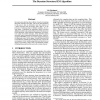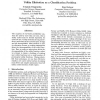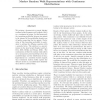135
Voted
UAI
1998
15 years 2 months ago
1998
In recent years there has been a flurry of works on learning Bayesian networks from data. One of the hard problems in this area is how to effectively learn the structure of a beli...
103
click to vote
UAI
1998
15 years 2 months ago
1998
The majority of real-world probabilistic systems are used by more than one user, thus a utility model must be elicited separately for each newuser. Utility elicitation is long and...
73
Voted
UAI
1998
15 years 2 months ago
1998
102
Voted
UAI
1998
15 years 2 months ago
1998
The monitoring and control of any dynamic system depends crucially on the ability to reason about its current status and its future trajectory. In the case of a stochastic system,...
100
Voted
UAI
1998
15 years 2 months ago
1998
Recent research in decision theoretic planning has focussedon making the solution of Markov decision processes (MDPs) more feasible. We develop a family of algorithms for structur...
104
click to vote
UAI
2003
15 years 2 months ago
2003
Precision achieved by stochastic sampling algorithms for Bayesian networks typically deteriorates in face of extremely unlikely evidence. To address this problem, we propose the E...
125
Voted
UAI
2003
15 years 2 months ago
2003
Collaborative filtering (CF) and contentbased filtering (CBF) have widely been used in information filtering applications, both approaches having their individual strengths and...
110
Voted
UAI
2003
15 years 2 months ago
2003
Published experiments on spidering the Web suggest that, given training data in the form of a (relatively small) subgraph of the Web containing a subset of a selected class of tar...
126
Voted
UAI
2003
15 years 2 months ago
2003
We propose a framework to extend Markov random walks (Szummer and Jaakkola, 2001) to a continuum of points. In this framework, the transition probability between two points is the...
118
Voted
UAI
2003
15 years 2 months ago
2003
A fundamental question in causal inference is whether it is possible to reliably infer the manipulation effects from observational data. There are a variety of senses of asymptot...



